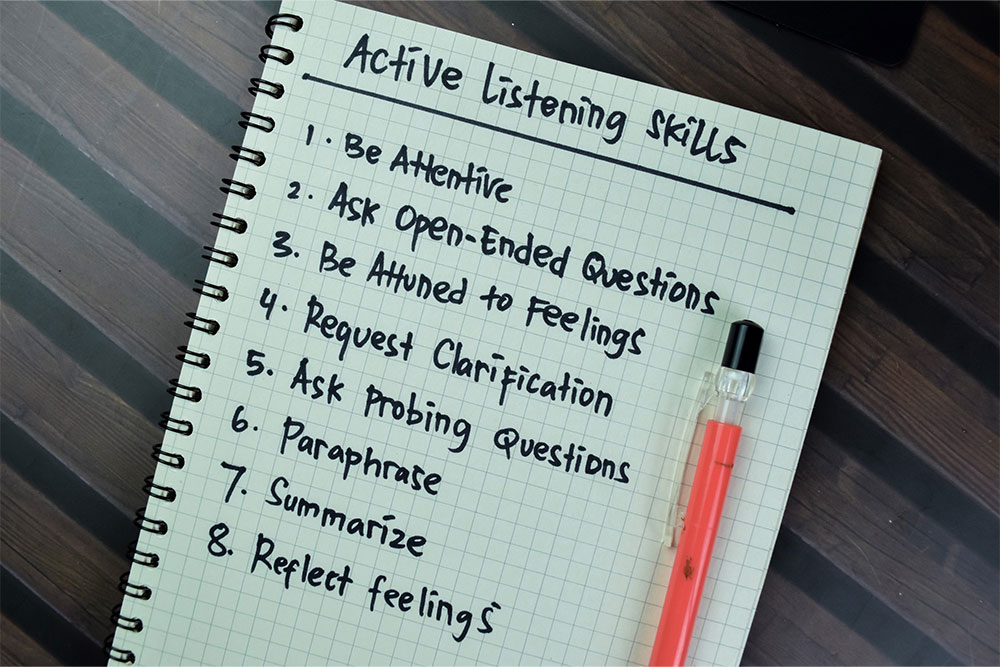
Have you ever been talking with your manager, nodding along, before turning back to your desk and instantly forgetting what they said?
You probably heard them. But did you listen?
Listening is an active skill. It takes effort and knowledge to do it properly. But knowing how to improve active listening in communication helps you have more worthwhile interactions at work.
Read our guide to learn how to start actively listening at work and why you need to do it.
What is Active Listening?
For most of us, hearing is a passive activity. You hear things without any conscious effort required.
Listening is active. You focus on sounds or voices to understand something.
Active listening is the step beyond. It’s listening with full attention and entirely focusing on the speaker.
It takes practice and a considerable amount of effort to do. But over time, you can master active listening techniques to the point where it becomes much more manageable.
How Does Active Listening in Communication Help?
It might be hard to believe, but no one talks just because they like to hear their voice.
When someone’s communicating, they expect something back from the other person. It might be something straightforward – a nod, an answer, a cup of tea – or something more complex.
Either way, if you’re not listening, you can’t understand what people need. And if you don’t know what people need, you can’t respond in a way that moves the conversation forward. The speaker grows frustrated, communication breaks down and relationships don’t grow.
Active listening skills allow you to pick up on what you really need to do for the other person, both figuratively and literally. It also helps strengthen relationships and primes your conversation partner to give you the attention you’d expect when talking.
(But don’t get too hung up on this last point – active listening in communication is all about putting the other person first.)

How to Become an Active Listener
It’s going to take practice to build your active listening skillset. Because you can’t fully listen to someone if you’re also focusing on yourself. So, expect it to take a little time before fully grasping the active listening techniques below.
Listen Before Making a Decision
We naturally fear the worst when someone says they want to speak to us, particularly at work. An unexpected “Have you got five minutes for a chat?” can unsettle anyone.
But this is the first lesson: don’t assume the worst.
Suppose you’ve put your defences up before a word’s even been spoken. In that case, you’ve probably already lost your chance of having a productive conversation.
Try to put your feelings out of your mind and listen to the other person.
Be Patient
You need to give people the time to speak. We sometimes need to pause to think of the right word or phrase. Or sometimes, we need to say something aloud before fully understanding its implications.
If you constantly interrupt someone, you’re robbing them of this chance. Not to mention you’re shifting focus away from them and onto yourself.
And it’s never helpful to finish someone’s sentence for them. Even if you know with every fibre of your being what the next word out of someone’s mouth will be, do not say it. Be patient and give your conversation partner the time to fully finish their piece before you utter a word.
Consider Your Body Language
You can’t speak and listen simultaneously, but you can still communicate. Your body language and facial expression can speak volumes when listening to someone.
You want to position yourself in a way that shows you’re focused on the conversation and keen to listen. Keep your body turned towards the speaker, nod your head and maintain healthy eye contact. It shows you’re invested in the conversation.
And if it’s appropriate, smile. It encourages your conversation partner and shows interest in their words.
Listen for the Hidden Meanings
Active listening in communication isn’t just about picking up on the words. It’s also about noticing feelings and intentions. And these aren’t always clear or verbalised.
Listen for tone of voice or specific language choices. And just as when you’re communicating non-verbally, look for your partner’s cues.
Repeat and Rephrase
You’ve listened without judgement or interruption. You’ve shown interest non-verbally. You’ve picked up on the other person’s emotions.
Time to prove you’ve really been listening.
When it’s your turn to respond, rephrase and repeat what the other person said. This is an excellent proof that you’ve heard what they’ve said and helps you internalise the important points.
And throw a few of the specific words or terms your partner has used back at them. This helps show you’ve listened and understood them.
You should try this technique throughout a conversation, but it’s essential at the end of any exchange. Use the repeat and rephrase tactic to summarise what you’ve taken from the conversation and confirm you know what’s expected of you.
The Most Important Skill
You can think of this as the golden rule of active listening:
Don’t just listen to reply.
Suppose you’re only waiting for your turn to speak or formulating a response in your head while the other person’s talking. In that case, you’ll never be able to give them your full attention.
This approach might slow down the pace of your conversations, but it’s worth it. Remember, you’ll have your turn to speak. And you’ll have a much better idea of what to say if you’ve actively listened.
What About Other Communication Skills?
Active listening is a critical communication skill. But it’s not the only one. You’ve also got to be able to get your points across too.
Our online Communication Skills Training covers every part of effective communication to help you advance in the workplace. You’ll learn how to empathise, build rapport, and identify communication barriers that can lead to misunderstandings. Start communicating better at work and avoid frustration or wasted time with crossed wires.
About the author(s)






















































































































































































































































































































































































































































































































































